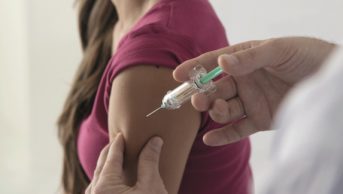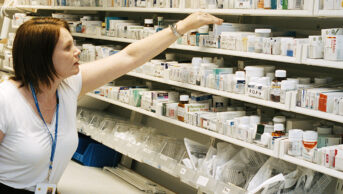
Shutterstock.com
Sexually transmitted infections (STIs) have been highlighted frequently in media stories in the past year, many of which have been negative with headlines such as “Highest syphilis rates since 1949!” and “Untreatable gonorrhoea superbug!”[1]
,[2]
. To understand the context of where we are with sexual health as a nation, we will need to go beyond the headlines to look at figures for syphilis, chlamydia, gonorrhoea and genital warts, with a particular focus on antibiotic-resistant gonorrhoea and the current state of sexual healthcare in England.
The facts
Public Health England (PHE) produces annual figures on the rate of new diagnoses of several STIs. In 2016, in England alone there were approximately 420,000 STI cases which, despite the dramatic headlines, actually marked a 4% decline compared with the year before[3]
. However, that small decline is driven largely by explicable declines in particular STIs and masks a significant increase in other STIs and marked increases in particular risk groups. What is unchanged is the fact that the impact of STIs remains greatest in young heterosexuals (aged 15 to 24 years), black ethnic minorities and men who have sex with men (MSM).
What has improved?
More than 62,000 cases of first-episode genital warts accounted for 15% of STIs in England in 2016, the second most common STI. However, this was an 8% decline on 2015 figures. The drop has been particularly marked in girls aged 15 to 17 years and the rates reported in 2016 show a 74% decrease relative to 2009. This is due to the roll-out of vaccination of school-age girls against human papilloma virus (HPV), the cause of genital warts and almost all cases of cervical cancer. The predicted impact of ‘herd immunity’, a benefit for boys despite limiting vaccination to girls, was demonstrated by a 63% drop in new cases of genital warts in males aged 15 to 17s over the same time period. However, it is arguable that the overall decline may have been even greater had the vaccine been made available to boys and to older, at-risk individuals, including MSM. There is on-going debate, despite national recommendations, about broadening the availability of HPV vaccination. In the interim, PHE and NHS England are supporting a pilot offering HPV vaccination to MSM, aged 45 and under, attending participating sexual health clinics[4]
,[5]
.
Compared with 2015, gonorrhoea diagnoses in England also fell in 2016, by 12% overall (a total of just over 36,000 cases). Rates in heterosexuals were static and the drop was driven by a 22% decline in MSM. Why gonorrhoea in MSM has declined is not clear but the decline is similar to the 23% drop in new HIV diagnoses among MSM attending sexual health clinics in England between 2015 and 2016. Clinics that have reported the greatest decline in new HIV diagnoses have also described a corresponding increase in testing frequency, likely driven at least in part by HIV-negative MSM, who are accessing HIV pre-exposure prophylaxis online, attending clinics for monitoring and STI screening. It is possible more frequent screening is also facilitating prompter diagnosis, treatment and contact tracing (the identification and diagnosis of people who may have come into contact with an infected person) for gonorrhoea, thus reducing the potential for onward transmission. However, the fall in cases coincides with a rise in concern about gonorrhoea due to increasing reports of strains resistant to antibiotics.
What has stayed the same?
Chlamydia diagnoses accounted for 49% of all STIs in England 2016 but the number of cases has remained relatively stable. The rise in MSM between 2015 and 2016 was minimal at 1%. Again, why chlamydia rates are stable in the context of gonorrhoea going down is not clear. Among young people aged 15 to 24 years chlamydia cases declined by 2% between 2015 and 2016. However, the number of chlamydia tests dropped by even more — 7% over the same time period. This is concerning because, firstly, chlamydia testing in such a high-risk group (young people aged 15 to 24 years account for almost two-thirds of all heterosexual chlamydia cases) has gone down. And secondly, it demonstrates that apparent stabilisation or improvement in STI rates can be driven by reduced testing coverage. This is particularly important considering the dramatic changes in sexual healthcare provision over recent years. Reduced access secondary to ‘efficiencies’ may not trigger an upsurge in STI rates, at least in the short term, since fewer tests mean fewer opportunities to diagnose infections.
What has become worse?
Syphilis rates in heterosexuals remain stable at around 1,000 cases per year but cases in MSM continue to rise steeply. The number of new cases in 2016 is indeed the highest number since 1949, which has caused alarm among the mainstream media. Since 2012, syphilis cases have almost doubled and that is predominantly due to infections in MSM. Rising syphilis rates may be driven by changes in MSM sexual behaviour. Evidence that HIV suppression through medication dramatically reduces the risk of onward transmission to HIV-negative partners has accumulated over the last five years or so and, more recently, “undetectable = uninfectious” campaigns have gained widespread publicity. The resultant changes in condom use and serosorting behaviour (the practice of using HIV status as a decision-making point in choosing sexual behaviour) may have contributed to increased syphilis transmission.
Reduced access secondary to ‘efficiencies’ may not trigger an upsurge in STI rates, at least in the short term, since fewer tests mean fewer opportunities to diagnose infections.
However, behaviour change as the cause of rising syphilis does not fit with static chlamydia and declining gonorrhoea cases. One theory about why syphilis continues to rise inexorably compared with other bacterial STIs is that much of the increase has been in HIV-positive MSM and antiretroviral therapy (ART) may increase susceptibility to syphilis. A number of studies have shown that combination ART is an independent risk factor for acquiring syphilis, and there is some evidence to support a negative impact of ART on syphilis-specific immune responses[6]
. As the recommended frequency of monitoring related to ART treatment declines, there is a risk that people living with HIV will not attend for STI screening as frequently as recommended and HIV services may need to implement extra efforts to promote STI screening, such as reminders or the use of home-testing kits[7]
.
Drug-resistant gonorrhoea: a global challenge
Alarming headlines about gonorrhoea and drug resistance have abounded, particularly in recent years. It is important to realise that gonorrhoea resistance is nothing new and the sequential use of different antibiotics over time has seen the consistent emergence of resistance and the need to revise treatment guidelines. We have long known that quinolone, penicillin and tetracycline resistance rates make these classes a suboptimal treatment choice, but it is the emergence of resistance to extended spectrum cephalosporins (ESC), first choice for gonorrhoea treatment, that has raised concern. Fears of an untreatable ‘superbug’ are not without foundation. The recent surge in media interest was triggered by a World Health Organization (WHO) news release flagging concerns about new cases of resistance in resource-rich countries where such surveillance is routine[8]
. The article highlighted that this may be just the tip of the iceberg. Resource-limited settings, which shoulder the burden of gonorrhoea, lack the surveillance and reporting systems to describe the scale of the problem. Globally, there are an estimated 78 million gonorrhoea infections every year. Cases in England account for less than 0.05% of that.
Antiretroviral therapy may increase susceptibility to syphilis
The data that triggered the WHO announcement was an analysis of gonorrhoea resistance surveillance between 2009 and 2014 from the WHO Global Gonococcal Antimicrobial Surveillance Programme (WHO GASP)[9]
. Globally, resistance to azithromycin has increased to 81% (currently British guidelines recommend dual therapy with azithromycin plus ceftriaxone although these are being revised currently) as has resistance to ESC, which has been reported in more than 50 countries[10]
. ESC is the only effective treatment option in most countries so the rising reports of resistance to cefixime, and more rarely to ceftriaxone, are concerning. Like the current British guidelines, the WHO gonorrhoea guidelines were updated in 2016 to move from cefixime to azithromycin/ceftriaxone dual therapy first-line.
The complications of gonorrhoea at global level are huge. Increased HIV transmission, infertility, and neonatal eye infection, to name a few. There is a small number of new antibiotics in the pipeline: solithromycin (phase III trial recently completed), zoliflodacin and gepotidacin (both have completed phase II trials). However, as the WHO highlights, gonorrhoea is not a particularly attractive area for pharmaceutical companies since treatment is short term and there is a risk of limited drug lifespan due to the emergence of resistance[11]
. In response, the Drugs for Neglected Diseases initiative (DNDi) and WHO have launched the Global Antibiotic Research and Development Partnership (GARDP), a not-for-profit research and development organisation which will prioritise gonorrhoea. However, this will not provide a quick solution and without addressing the factors that contribute to the sequential failure of antibiotics due to resistance development, the problem will continue.
The key to understanding and targeting epidemics is accurate data, but there are huge gaps globally in our knowledge about testing, case numbers, treatment used and resistance rates. African and eastern Mediterranean countries are under-represented in the WHO GASP. Back in 2012, the WHO released a fact sheet which called for a number of interventions to limit the threat of resistant gonorrhoea by meeting two overlapping goals: broad-based control of drug resistance, and control of gonorrhoea[11]
. In addition to appropriate education, prevention tools, and screening and treatment, these included:
- Effective drug regulations;
- Better resistance surveillance, where gonorrhoea is common;
- Regional, well-controlled laboratory networks for gonococcal culture;
- Systematic monitoring of treatment failures with standard definitions and protocols for monitoring;
- Research into newer methods for monitoring and detecting resistance;
- Identification of, and research into, alternative treatment regimes.
Education about STI prevention and access to appropriate risk reduction advice, condoms, STI screening and timely treatment are essential. Contact tracing and partner notification are an important element of STI management yet this very type of activity may be neglected, not only in resource-limited settings but also in the resource-rich settings where sexual health budgets are being endlessly tightened. Certainly in the UK, we lack the staff resource and widespread access to shared IT access that would facilitate better data collection and opportunity to analyse the public health impact of robust partner notification and treatment.
Globally, there are an estimated 78 million gonorrhoea infections every year
How to slow resistance
An essential step to slow antibiotic resistance for STIs and protect both current and future antibiotics is to ensure timely, accurate diagnosis. Many parts of the world do not have access to appropriate diagnostics, so may treat STIs based only on symptoms. This risks inappropriate antibiotic prescribing and the development of resistance in gonorrhoea and other micro-organisms, not just those associated with STI. This is important given the increased travel abroad of British citizens and visitors to the UK year on year.
Similarly, many people with gonorrhoea report no or minor symptoms so remain undiagnosed and untreated. Modern, rapid STI tests can significantly reduce time from testing to treatment, which, in turn, may reduce the period of infectivity and rate of onward transmission, but affordable rapid tests, including point-of-care methods, are lacking[11]
. Where appropriate tests are available we must ensure they are used appropriately. The pharynx is a common site and important reservoir for gonorrhoea infection and is thought to be the main source of new infections in MSM, exacerbated by the practice of using saliva as a lubricant[12]
.
Ideally, point-of-care gonorrhoea tests would also provide information about drug susceptibility enabling immediate initiation of appropriate antibiotics. Until a time when that technology is available routinely, treatment guidelines must be updated regularly to reflect resistance patterns. Resistance, once acquired, tends to persist within gonorrhoea populations even when antibiotic pressure is withdrawn, suggesting there is no significant impact on resistance on biological fitness (the ability of the bacteria to survive). Indeed, resistance can be linked to increased fitness of the organism[13]
.
An ultimate goal in the fight against gonorrhoea is the development of an effective vaccine. This has proved elusive so far. The extensive antigenic variation displayed by the organism, combined with the mechanisms it uses to evade the host immune response and the lack of protective immunity after an infection, have all impeded progress with vaccine development[13]
. Recently, hope for a vaccine has been reinvigorated by evidence that Neisseria meningitidis serogroup B vaccine MeNZB was associated with decreased rates of gonorrhoea.
MeNZB was developed in New Zealand against a particular meningococcal B strain linked to a rise in cases in the late 1990s. Between 2004 and 2008 the vaccine was offered to infants and young people under 20 years of age and the last phase of the programme, immunisation for people with a high medical risk, ended in March 2011[14]
. In total, more than 1.1 million people received the MeNZB but it was not used outside New Zealand.
N. meningitidis and N. gonorrhoeae are closely related organisms. In 2014 a modelling study, based on predicted cross-reactivity between 4CMenB and N. gonorrhoeae, predicted that efficacy as low as 20% would still result in a substantial reduction in gonorrhoea infections and associated costs[15]
. This year, a retrospective case-control analysis of 15 to 30 year olds who were eligible to have received the MeNZB vaccine in New Zealand demonstrated an estimated vaccine effectiveness against gonorrhoea of 31%[16]
.
MeNZB is no longer available but a different meningococcal B vaccine, Bexsero, was added to the routine immunisation schedule in the UK in 2015[17]
. In addition to other components, Bexsero contains the same antigen as MeNZB, so it is possible that this vaccine, too, will confer cross-protection against gonorrhoea, but since this vaccine it not offered routinely outside the UK and has only been provided to infants since 2015 we will not know the answer to that any time soon[18]
.
Finally, returning to pharyngeal gonorrhoea, gargling could be a possible solution. An Australian trial showed that gargling with Listerine significantly reduced bacterial counts in men with pharyngeal gonorrhoea infection — whether regular gargling could impact gonorrhoea rates could be investigated in a larger trial[19]
.
Sadly, in the current political and commissioning climate, short-term costs override cost-effectiveness
Public health funding gap
STIs such as gonorrhoea will continue to adapt to the barriers we raise against it. Although the infective agent was not identified until 1879, gonorrhoea as a disease was first described about 3,500 years ago and it will probably be with us for a few more years yet[13]
. However, we will not be equipped to fight this infection without accessible and appropriately funded sexual health services.
Since 2012, which saw the introduction of the Health and Social Care Act, sexual health is no longer commissioned by the NHS but by local authorities which receive a public health budget to provide sexual health care. The huge reductions in public health spending, and consequent declines in sexual health funding, have led to reconfiguration, and in some cases closure, of services[20]
,[21]
.
Moving forward, STI testing rates and attendance figures will need to be monitored closely to ensure that any deterioration that risks negative health outcomes is detected promptly and action taken. Unfortunately, significant stigma still surrounds sex and STIs, which disproportionately affect the vulnerable and marginalised. This makes advocating for change and keeping sexual health on the political agenda a challenge. Providing sexual health and contraception services are highly cost-effective in terms of the consequences of untreated infection and unplanned pregnancies but, sadly, in the current political and commissioning climate, short-term costs override cost-effectiveness. The focus on short-term savings, if unchecked, will cost us all much more in the longer term.
Laura Waters is consultant physician in genitourinary medicine at Central and North West London NHS Foundation Trust and a trustee of the charity Terrence Higgins Trust.
References
[1] Cases of syphilis hit highest level in England since 1949. The Guardian 6 June 2017. Available at: https://www.theguardian.com/society/2017/jun/06/cases-of-syphilis-hit-highest-level-in-england-since-1949 (accessed October 2017)
[2] Rudd J. Untreatable gonorrhoea ‘superbug’ spreading around world, WHO warns. The Guardian 7 July 2017. Available at: https://www.theguardian.com/society/2017/jul/07/untreatable-gonorrhoea-superbug-spreading-around-world-who-warns (accessed October 2017)
[3] Public Health England. Sexually transmitted infections and chlamydia screening in England, 2016. Available at: https://www.gov.uk/government/uploads/system/uploads/attachment_data/file/617025/Health_Protection_Report_STIs_NCSP_2017.pdf (accessed October 2017)
[4] Joint Committee on Vaccination and Immunisation. JCVI statement on HPV vaccination of men who have sex with men. November 2015. Available at: https://www.gov.uk/government/uploads/system/uploads/attachment_data/file/477954/JCVI_HPV.pdf (accessed October 2017)
[5] Joint Committee on Vaccination and Immunisation . JCVI statement on HPV vaccination of men who have sex with men. Available at: https://www.gov.uk/government/publications/hpv-vaccination-pilot-for-men-who-have-sex-with-men-msm (accessed October 2017)
[6] Rekart ML, Ndifon W, Brunham RC et al. A double-edged sword: does highly active antiretroviral therapy contribute to syphilis incidence by impairing immunity to Treponema pallidum? Sex Transm Infect 2017 Jan 16. doi: 10.1136/sextrans-2016-052870
[7] British HIV Association. British HIV Association guidelines for the routine investigation and monitoring of adult HIV 1 positive individuals 2016. Available at: http://www.bhiva.org/documents/Guidelines/Monitoring/2016-BHIVA-Monitoring-Guidelines.pdf (accessed October 2017)
[8] World Health Organization. Antibiotic-resistant gonorrhoea on the rise, new drugs needed. 7 July 2017. Available at: http://www.who.int/mediacentre/news/releases/2017/Antibiotic-resistant-gonorrhoea/en/ (accessed October 2017)
[9] Wi T, Lahra MM, Ndowa F et al. Antimicrobial resistance in Neisseria gonorrhoeae: global surveillance and a call for international collaborative action. PLoS Med 2017;14(7):e1002344. https://doi.org/10.1371/journal.pmed.1002344
[10] BASHH gonorrhoea guidelines. Available at: https://www.bashh.org/guidelines (accessed October 2017)
[11] World Health Organization. Emergence of multi-drug resistant Neisseria gonorrhoeae — threat of global rise in untreatable sexually transmitted infections. Available at: http://apps.who.int/iris/bitstream/10665/70603/1/WHO_RHR_11.14_eng.pdf (accessed October 2017).
[12] Chow EP, Cornelisse VJ, Read TR et al. Saliva use as a lubricant for anal sex is a risk factor for rectal gonorrhoea among men who have sex with men, a new public health message: a cross-sectional survey. Sex Transm Infect 2016 Mar 3. pii: sextrans-2015-052502. doi: 10.1136/sextrans-2015-052502
[13] Hill SA, Masters TL, Wachter J. Gonorrhoea — an evolving disease of the new millennium. Microb Cell 2016;3(9):371–389. doi: 10.15698/mic2016.09.524
[14] Ministry of Health New Zealand. Meningococcal B immunisation programme and MeNZBâ„¢ vaccine. Available at: http://www.health.govt.nz/our-work/preventative-health-wellness/immunisation/immunisation-programme-decisions/meningococcal-b-immunisation-programme-and-menzbtm-vaccine (accessed October 2017)
[15] Régnier SA, Huels J. Potential impact of vaccination against Neisseria meningitidis on Neisseria gonorrhoeae in the United States: results from a decision-analysis model. Hum Vaccin Immunother 2014;10(12):3737–45. doi: 10.4161/hv.36221
[16] Petousis-Harris H, Paynter J, Morgan J et al. Effectiveness of a group B outer membrane vesicle meningococcal vaccine against gonorrhoea in New Zealand: a retrospective case-control study. Lancet 2017 Jul 7. pii: S0140–6736(17)31449–31446. doi: 10.1016/S0140-6736(17)31449-6
[17] Meningococcal meningitis and septicaemia notifiable. Meningococcal September 2016. Available at: https://www.gov.uk/government/uploads/system/uploads/attachment_data/file/554011/Green_Book_Chapter_22.pdf (accessed October 2017)
[18] Seib KL. Gonorrhoea vaccines: a step in the right direction. Lancet 2017 Jul 7. pii: S0140-6736(17)31605–31607. doi: 10.1016/S0140-6736(17)31605-7
[19] Chow EP, Howden BP, Walker S et al. Antiseptic mouthwash against pharyngeal Neisseria gonorrhoeae: a randomised controlled trial and an in vitro study. Sex Transm Infect 2017;93(2):88–93. doi: 10.1136/sextrans-2016-052753
[20] Kentish B. Sexual health clinics ‘at tipping point’ after Government cuts and huge rise in demand, councils warn. The Independent 2 August 2017. Available at: http://www.independent.co.uk/news/uk/home-news/sexual-health-clinics-breaking-point-government-cuts-local-government-association-hiv-gonorrhoea-a7874076.html (accessed October 2017)
[21] Sexual health budget cuts are putting lives at risk – including those at risk of child exploitation. The Independent 4 August 2017. Available at: http://www.independent.co.uk/voices/letters/sexual-health-budgets-prisons-mental-health-lack-of-funding-government-justify-a7876651.html (accessed October 2017)


